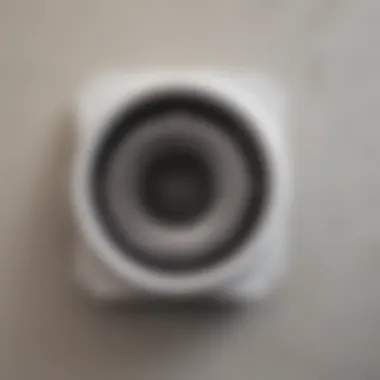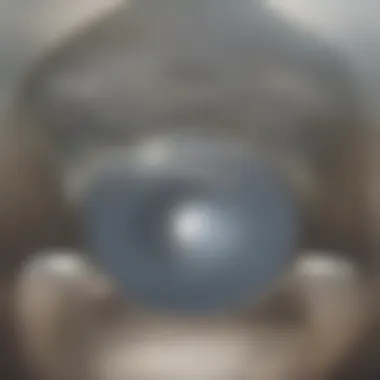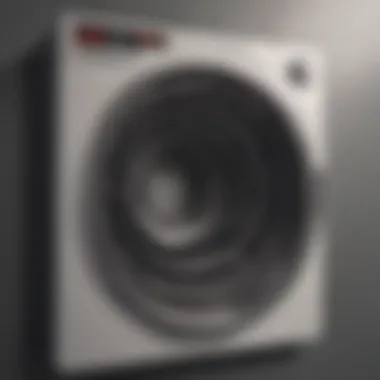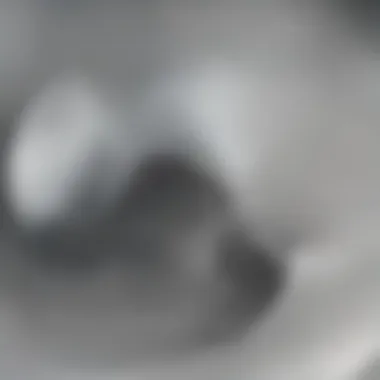The Essential Guide to Internal Dryer Vents


Intro
Internal dryer vents represent a crucial yet often overlooked component of home ventilation systems. Understanding their design and functionality is essential for ensuring that your dryer operates effectively and safely. The importance of a well-designed venting system cannot be understated, as it plays a significant role in both the efficiency of the appliance and the safety of your home.
As we explore the features, installation methods, maintenance needs, and safety concerns related to internal dryer vents, it becomes clear how best practices can prevent common issues like lint buildup. Furthermore, by choosing the right materials and adhering to local building codes, homeowners can optimize the performance of their dryers.
This guide provides insights not only into the operational mechanics of internal dryer vents but also the steps necessary for proper upkeep.
Home Features
Internal Vent Design
The design of internal dryer vents typically involves a system of ducts that carry moist air and lint away from the dryer. They can be routed through walls or ceilings, which sometimes presents unique challenges compared to standard external venting. Internal vent systems often incorporate a combination of rigid and flexible ducts to accommodate different layouts of a home.
Installation Considerations
Installing internal dryer vents requires careful planning. Factors to consider include:
- Length of Ducts: Shorter ducts are more efficient and reduce the risk of lint accumulation.
- Type of Duct Material: Smooth metal ducting reduces friction and lint buildup, compared to plastic or vinyl options.
- Vent Location: Placing vents in easily accessible areas can simplify maintenance and cleaning.
For optimal performance, these elements must be balanced to ensure compliance with local building codes.
Proper installation of dryer vent systems is crucial for safety and efficiency; neglecting it can lead to dangerous fire hazards.
Maintenance Practices
Regular maintenance is vital to keep internal dryer vents functioning well. Here are some recommended practices:
- Cleaning Schedule: Clean vents at least once a year or more frequently if using the dryer often.
- Lint Removal: Empty the lint trap after every use to prevent lint buildup, especially in internal ducts.
- Check Connections: Ensure there are no loose connections or leaks, which can hinder airflow.
By following these steps, homeowners can significantly reduce risks associated with dryer use.
Safety Concerns
Internal dryer vents carry unique safety concerns. The risk of fire is heightened by lint accumulation, and improper venting can cause moisture buildup, leading to mold growth. Homeowners should remain vigilant for any signs of malfunction, such as overheating or prolonged drying times.
Understanding Internal Dryer Vents
Internal dryer vents serve a crucial purpose in effectively venting moisture and exhaust from clothes dryers. Unlike traditional external venting systems, internal dryer vents are utilized when an external venting solution is not practical or feasible. They often appear in urban settings or in homes where structural limitations inhibit the installation of an external duct.
The significance of this topic is elevated by the fact that understanding internal dryer vents is key to achieving optimal dryer performance. It encompasses various elements such as design considerations, installation methods, and maintenance practices. By grasping these core concepts, homeowners and real estate enthusiasts can ensure the efficient operation of their dryers while minimizing potential hazards.
Definition and Purpose
Internal dryer vents are essentially ducts designed to transport moist air and lint from dryers to a designated area within a building, such as the attic or basement. Their purpose is to prevent the accumulation of heat and humidity, which can lead to damage in the home and potentially hazardous situations.
The primary function of an internal vent is to facilitate airflow out of the dryer while capturing lint. Unlike external systems, internal vents require regular maintenance to prevent lint buildup. Without proper cleaning, this lint can obstruct the vent, resulting in reduced efficiency and safety risks.
Comparative Overview with External Vents
When comparing internal dryer vents to external ones, several key differences emerge. External vents typically connect directly to the outdoors, allowing moist air and lint to escape freely. This approach reduces the likelihood of lint accumulation and minimizes potential hazards. On the other hand, internal vents necessitate more diligence regarding their maintenance due to the confined space in which they operate.
- Advantages of Internal Vents:
- Disadvantages of Internal Vents:
- Suitable for locations lacking external access.
- Can be easier to install in certain building layouts.
- Higher risk of lint buildup and blockages.
- Potential for increased humidity levels inside the home, which can lead to mold growth.
In summary, both types of vents have their unique advantages and challenges. Understanding these can guide homeowners in making informed decisions regarding their dryer ventilation systems.


Design Considerations for Internal Dryer Vents
Design considerations for internal dryer vents are crucial. This involves multiple factors such as material selection, sizing, and layout. Properly designed vents enhance the efficiency of the dryer while reducing risks. Attention to these details can lead to better airflow and lower energy consumption.
Material Selection
Material selection is a pivotal factor when dealing with internal dryer vents. The choice of material affects durability, maintenance, and efficiency. Stainless steel is often recommended for its resilience against heat and corrosion. Aluminum is lightweight and usually more affordable but may not last as long as stainless steel. Plastic should be avoided because it can warp and is prone to fire hazards. Implementing the right materials can significantly reduce lint buildup and the risk of fire, making your dryer system safer.
Sizing Requirements
Sizing requirements must be methodically calculated. An inadequate vent can create excessive backpressure, reducing dryer efficiency. A vent that is too small might not effectively expel hot, moist air, leading to prolonged drying times and potential overheating. Ideally, the vent diameter should match the manufacturer's specifications, often around four inches for most residential dryers. Conditions in the installation area might necessitate adjustments, so understanding the specifics is key.
Layout and Routing
The layout and routing of the internal dryer vent are essential for optimal performance. The path should be as direct as possible to reduce friction and air resistance. Ideally, you want to minimize the use of elbows and bends, as these can restrict airflow and increase lint accumulation. If bends are necessary, using gradually angled elbows can help. Additionally, avoid long runs of venting, as more length can exacerbate these issues. Proper layout not only enhances the efficiency but also contributes to the longevity of the vent system.
"Selecting the right materials, understanding sizing, and planning the layout are foundational steps for effective internal dryer vent systems."
Installation Guidelines
Installation of internal dryer vents can significantly affect both efficiency and safety in your home. The process demands careful attention due to unique challenges posed by internal venting. Unlike external systems, internal vents often require different considerations for material, size, and technical setup. Addressing these facets effectively can lead to improved dryer functionality and reduced risk of hazards.
Required Tools and Materials
Before embarking on the installation journey, it is important to gather all necessary tools and materials. This helps in having a smooth experience. Essential tools include:
- Drill: Needed for making holes in walls, connecting parts.
- Screwdriver: A flathead or Phillips, depending on screws used.
- Tape Measure: Ensures proper sizing of ducts and placements.
- Level: To make sure the vent is properly aligned.
Additionally, choose the right materials for constructing the vent system. These should include:
- Rigid Ducting: Preferred for better airflow.
- Flexible Ducting: Useful in tight spaces but can reduce efficiency.
- Vent Hoods and Screens: To prevent debris and pests from entering.
Step-by-Step Installation Process
- Plan Your Layout: Determine the best route for the ductwork. Make sure it is as short and straight as possible to reduce lint buildup.
- Cut the Ducting to Size: Use your tape measure to get precise lengths needed for your installation. Cut accordingly.
- Install Wall Plates: If needed, position wall plates where the duct will exit or enter. This helps with stability and aesthetics.
- Connect Duct Sections: Use screws or duct tape. Ensure each joint is tight to prevent air leaks which could reduce efficiency.
- Secure the Ducts: Ensure that the ducts are securely attached to the wall and floor to avoid any movement during operation.
- Test the System: Run the dryer on a low cycle to check for air leaks or blockages. Ensure lint trap is properly in place.
Professional Installation vs. DIY
Choosing between professional installation and DIY depends on your comfort level and skills.
- Professional Installation: Hiring an expert can be beneficial. They have experience, knowledge of codes, and can troubleshoot problems effectively. Pros can also guarantee that the system will be installed safely and efficiently, adhering to local building regulations.
- DIY Installation: If you are handy and enjoy home projects, as long as you follow safety measures and guidelines, you can save money. Ensuring you have all correct tools and instructions is vital for this choice.
Always assess your own skills before deciding. Making mistakes in installation can have serious consequences.
"Proper installation determines the longevity of your dryer vent system. Ignoring the guidelines can lead to inefficiencies or hazards."
In summary, understanding installation guidelines is essential for maximizing dryer performance and ensuring safety. By being well-informed about required tools, the installation process, and options between professional help or DIY, you can make sound decisions that enhance home efficiency.
Maintenance Practices for Internal Dryer Vents
Maintaining internal dryer vents is crucial for both operational efficiency and safety. These vents can accumulate lint, dust, and moisture over time, leading to various issues. Regular maintenance helps to avert potentially catastrophic events such as fires and mold growth. It also ensures that the dryer operates at peak performance, thus prolonging its lifespan and reducing energy costs.
Importance of Regular Cleaning
Regular cleaning of internal dryer vents should not be underestimated. Lint is highly flammable and can quickly accumulate to dangerous levels. According to the National Fire Protection Association, failure to clean dryer vents is a leading cause of household fires. Therefore, keeping these vents clean is not just a matter of efficiency but also a vital fire safety measure. Additionally, by removing lint buildup, you enhance airflow, which improves drying times, prevents moisture damage, and reduces the energy consumption of the dryer.
Cleaning Methods and Tools
Effective cleaning requires the right methods and tools. Here are some recommended approaches:
- Vacuum Cleaner: Using a vacuum with a hose attachment can effectively remove lint from the vent. Ensure it has strong suction power to tackle more stubborn clogs.
- Lint Brush: A long-handled lint brush can reach deep into the vent and effectively grab lint that a vacuum might miss.
- Compressed Air: For those hard-to-reach spots, compressed air can dislodge lint buildup and carry it out of the vent.
- Professional Services: In some cases, hiring a professional service might be necessary. They have specialized equipment that can perform a thorough cleaning and identify any underlying issues with the vent system.


Frequency Recommendations
How often should one clean internal dryer vents? The consensus among experts suggests:
- Every 3 to 6 Months: If the dryer is used frequently, this is a good routine to adopt.
- Annually: For those who do not use their dryers often, a yearly cleaning may suffice.
- After Each Load: Check the lint trap after every use. It is also useful to look for signs of lint buildup, such as longer drying times or reduced airflow.
- If You Notice Issues: If you experience musty odors, dampness in laundry, or an increase in drying time, clean the vent immediately.
By implementing a consistent cleaning schedule, you can avoid numerous problems and enjoy a more efficient drying experience.
Safety Concerns Associated with Internal Dryer Vents
Internal dryer vents do offer some practical benefits but pose significant safety concerns that cannot be overlooked. Understanding these concerns is crucial for any homeowner or renter to ensure safety and efficiency in the drying process. The risks can be broadly categorized into fire hazards and health risks stemming from lint accumulation. Both of these areas deserve attention to prevent unnecessary dangers and maintain a safe living environment.
Potential Fire Hazards
One of the most critical issues related to internal dryer vents is the potential for fire hazards. Lint, a common byproduct of drying clothes, can accumulate within the venting system. If this lint build-up is not addressed, it can ignite and lead to a fire. According to the U.S. Fire Administration, clothing dryers are considered a significant source of home fires.
Here are some key factors related to fire hazards:
- Lint Accumulation: Regular cleaning is essential to reduce the risk of flammable lint build-up in the vent. It is recommended to clean the lint trap after each use and to check the vent regularly for clogs.
- Ventilation Design: Internal dryer vents may not provide the same airflow efficiency as external systems. Poor ventilation can increase the risk of overheating, which can also lead to fires.
- Material Quality: The materials used for internal ventilation ducts should resist heat and fire. Using non-combustible materials can greatly help in reducing fire risk.
"Regular maintenance and proper care of dryer vents significantly reduce fire hazards."
Ignoring these fire risks not only endangers life and property but could also void insurance claims in case of a fire. Therefore, ensuring that the internal dryer vent system is effectively designed and regularly maintained is essential for safeguarding against potential disasters.
Health Risks from Lint Accumulation
Beyond fire hazards, internal dryer vents can also pose health risks due to lint accumulation. Lint is not just a nuisance; it can harbor harmful substances and allergens that may affect indoor air quality.
Consider these important health aspects:
- Air Quality Issues: Lint can carry dust mites, mold spores, and other allergens that contribute to respiratory problems. When lint builds up, it can worsen indoor air quality, leading to symptoms such as coughing, sneezing, and eye irritation.
- Moisture Build-Up: Internal dryer vents can retain moisture more than external systems. This moisture encourages mold growth, which can lead to further health complications, especially for individuals with allergies or compromised immune systems.
- Chemical Exposure: Many fabrics contain chemicals that may release volatile organic compounds (VOCs) during drying. Without a proper ventilation system, these VOCs can accumulate indoors, leading to headaches and long-term health issues.
To mitigate these risks, it is essential to perform regular maintenance. Cleaning the dryer vent and lint trap, along with ensuring proper ventilation, will help keep the air quality in your home safe. Keeping yourself informed about these safety concerns can help you make better decisions regarding internal dryer vents.
Local Building Codes and Regulations
Understanding local building codes and regulations is crucial for anyone interested in internal dryer vents. This section sheds light on why compliance with these codes is not just a necessary step but also a fundamental concern for safety and efficiency.
Local building codes vary by region and municipality. They set specific standards that govern the installation and operation of appliances, including dryers. These codes take into account various factors influencing safety, such as the construction type of a building, fire safety measures, and ventilation requirements. Not adhering to these guidelines can lead to severe consequences, including costly fines, safety risks, or even property damage.
Understanding Compliance Requirements
Compliance requirements with local building codes often include specific guidelines on materials, construction practices, and installation processes. Here are some elements to consider:
- Materials: Items used in dryer venting must be approved for use in your locality. For instance, certain types of flexible ducting may be prohibited due to fire hazards.
- Installation Height: Some codes dictate the maximum length of a dryer vent and the number of bends allowed. Each local authority may have different standards.
- Exit Points: Many jurisdictions require that vents exit to the exterior of the building rather than the interior, mitigating the risk of humidity buildup inside.
Ensuring compliance not only helps avoid legal repercussions but also assists in optimizing the performance of your dryer. Proper adherence to the regulations generally improves energy efficiency and minimizes the risk of lint accumulation, which could lead to a fire.
Permits and Inspections
In addition to knowing the compliance requirements, understanding permits and inspections is key for any dryer vent project. Most installations typically require a permit to ensure that the work meets local safety standards. Here’s what to know:
- Permit Applications: When applying for a permit, provide plans detailing the installation of your internal dryer vents. This may include diagrams of the vent routing and details on materials used.
- Inspections: After installation, an inspection may be required to verify that everything complies with the local codes. This provides an opportunity for missteps to be identified and corrected.
- Record Keeping: When engaging in any construction activity, maintaining organized records of permits and inspections ensures that the work is documented appropriately and can be referenced in the future.
Building codes are not merely bureaucratic mechanisms; they serve to protect the health and safety of occupants and help ensure that your systems work effectively and efficiently.
In summary, understanding local building codes and regulations is imperative for the installation and maintenance of internal dryer vents. This knowledge not only aids in achieving compliance but ultimately protects individuals and their property.
Troubleshooting Common Issues
Troubleshooting common issues in internal dryer vents is crucial for maintaining their efficiency and safety. Internal dryer vents can face unique challenges that require specific attention. Regular monitoring can prevent problems such as blockages and moisture accumulation, which can compromise functionality. Understanding how to troubleshoot these issues is vital for optimizing dryer performance and ensuring long-term operation.


Identifying Vent Blockages
Identifying blockages within dryer vents is an essential part of troubleshooting. Dust and lint are the primary culprits that accumulate over time, obstructing airflow. The presence of such blockages can lead to inefficient drying cycles and increased energy consumption. Signs that indicate a blockage include clothes taking longer to dry, unusual noises from the dryer, and increased heat emanating from the appliance.
To inspect the vent system:
- Disconnect the dryer from its power source to ensure safety.
- Examine the vent hose and ducts for any visible lint build-up or physical obstructions.
- Use a flashlight to look deep into the vent system for signs of blockage that are not visible from the outside.
Utilizing a vacuum cleaner with an attachment can help remove accumulated lint. If blockages persist, professionals can employ specialized tools for a thorough cleaning, ensuring optimal airflow once again.
Addressing Odors and Moisture Build-Up
The presence of odors and moisture build-up is another common issue that requires immediate attention. Stale smells can arise from trapped lint and debris, which provides a breeding ground for mold and mildew. This not only creates an unpleasant environment but can also lead to health issues due to the potential for allergens through mold spores.
To address these concerns, follow these steps:
- Perform regular checks for moisture accumulation in and around the dryer. Equipment like hygrometers can measure humidity levels in the vicinity.
- Ensure proper ventilation. Check that the venting system has no kinks or sharp bends that can restrict proper airflow.
- Use a dehumidifier in areas with high humidity to help mitigate moisture issues.
- Schedule routine cleanings to prevent odoriferous conditions.
Adopting these measures will enhance air quality and prevent smelling, stagnant environments from arising around your laundry area. Maintaining the integrity of the dryer vent is critical for efficient and safe operation.
Regular maintenance and troubleshooting can save money and prevent potential safety hazards.
Case Studies and Best Practices
Case studies and best practices provide valuable insights about internal dryer vents. They highlight practical applications, identifying successful techniques and offering lessons learned from real-life experiences. This section emphasizes the importance of understanding these case studies, as they reveal not only effective methods but also cautionary tales regarding what should be avoided. Incorporating evidence from various installations enhances our knowledge base, leading to improved design, installation, and maintenance practices.
Successful Installations
Successful installations of internal dryer vents often serve as benchmarks for others in the field. These projects illustrate proper practices, ensuring optimal efficiency while complying with safety standards. For example, some residential complexes utilize efficient duct materials and thoughtful layouts that minimize the risk of lint accumulation and allow systems to operate effectively. Key aspects of successful installations include:
- Material Quality: Using high-grade materials, like rigid metal ducts, prevents blockages compared to flexible plastic.
- Proper Sizing: Ensuring the vent size is appropriate for the dryer model to enhance airflow performance.
- Minimal Bends: Keeping ductwork as straight as possible reduces airflow resistance and minimizes lint buildup.
A notable case involved a multi-family unit which redesigned their vent system, focusing on direct vent paths and increased duct diameter. The improvements resulted in a significant reduction in dryer operation time and minimal maintenance issues.
Lessons Learned from Failures
Learning from failures is equally crucial in the realm of internal dryer vents. Mistakes occurring during installation or maintenance can lead to severe consequences, such as fire hazards or expensive repairs. One common failure point is underestimating the importance of thorough lint cleaning. Homeowners who neglect regular maintenance often face serious blockages that lead to inefficient dryer operation or even fires.
Several key lessons can be gathered from past failures:
- Ignoring Building Codes: Some installations have failed to meet local codes, leading to fines and mandatory corrections.
- Neglecting Venting Length: Exceeding recommended duct lengths causes condensation and reduces ventilation effectiveness.
- Poor Placement: Positioning the dryer vent near heat sources can compromise the system's integrity and increase fire risks.
For instance, one homeowner faced a serious fire incident because of obstructed ducts that were overlooked during regular checks. This scenario serves as a stark reminder of the importance of routine maintenance.
"Regular checks and cleaning of dryer vents can save lives and property. Ignoring this simple task can lead to catastrophic outcomes."
Innovative Technologies in Dryer Vent Systems
Innovative technologies are transforming dryer vent systems, making them safer, more efficient, and easier to maintain. As homeowners and industry professionals seek to improve dryer performance and energy efficiency, the integration of such technologies has become increasingly relevant. By understanding these advancements, individuals can make informed decisions that enhance the functionality of internal dryer vents.
Smart Ventilation Solutions
Smart ventilation systems utilize advanced sensors and automation to optimize airflow within dryer vent systems. These solutions can monitor humidity levels, temperature, and airflow rates, allowing the system to adjust itself based on real-time conditions. For instance, when the dryer is in use, the system can open additional airflow paths to reduce lint buildup and enhance drying efficiency.
These smart systems often come equipped with alarms or notifications when maintenance is required. This proactive approach reduces the risks associated with neglected ventilation, ensuring that clogs are identified and addressed promptly.
The benefits of smart ventilation solutions include the potential for reduced energy costs and prolonged dryer lifespan. When dryers operate efficiently, they consume less power. Moreover, by keeping vents clear and well-maintained, homeowners may prevent issues such as overheating that can lead to equipment failure.
Materials Advancements
Recent material advancements in the construction of dryer vents are addressing common issues related to lint build-up and fire hazards. Manufacturers are now utilizing non-combustible materials such as aluminum and specialized polymers that resist high temperatures and do not degrade easily. These materials enhance the safety profile of dryer vent systems.
Additionally, innovative coatings have been developed to minimize lint accumulation within the ducts. Smooth, non-stick surfaces help lint and debris to flow more freely, reducing the frequency of needed cleanings. This is particularly important in internal dryer vent systems where access to ductwork is often limited.
Using better materials not only contributes to safety but also supports energy efficiency. Newer materials can reflect heat better and improve airflow, which leads to shorter drying times and less wear on the dryer.
Adopting innovative technologies in dryer vent systems can significantly enhance the effectiveness and safety of internal vent installations.



